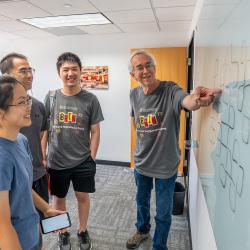Creating Chaos
Distinguished University Professor and renowned Mathematician and Physicist James Yorke, Ph.D. ’66, mathematics, came to UMD in 1963 as a mathematics graduate student. Today, he is known worldwide for coining the term “chaos” for the mathematical study of nonlinear dynamic systems. The term was introduced in a paper he authored with Michigan State Distinguished Professor Tien-Yien Li titled “Period Three Implies Chaos.” A founder and leader of the famed UMD nonlinear dynamics group, Yorke was honored in fall 2013 with the UMD President’s Award, the highest honor the campus bestows.
In 2003, he was awarded the Japan Prize, over which the Emperor of Japan presides. It is one of the most esteemed science technology prizes, ranked nearly on a par with the Nobel Prize and Fields Medal. He is a fellow of the American Physical Society, the American Association for the Advancement of Science (AAAS), the American Math Society and the Society for Industrial and Applied Mathematics. He spoke with us on the occasion of his 50th year at UMD.
What keeps you inspired?
I am inspired by the pursuit of new ideas. I love to come up with new and strange ideas; to discover something unknown and suddenly the idea becomes crystallized. After 50 years, my goal is still to come up with neat, strange ideas and tell people about them. That’s what keeps me motivated.
What has been an important factor in your success?
I don’t think of myself as being stuck in one area. I am now working in chaos with two graduate students and working in genomics with four senior postdoctoral researchers. About 15 years ago, I read in the newspaper that scientists had for the first time determined the genomic sequence of a bacteria. I had a good student and thought we could contribute to a project like that one. It has taken a few years, but now I believe our UMD team is better at determining DNA sequences than any other group. This year we assembled a pine tree genome that is about seven times bigger than the human genome. This is not related to chaos, it is just an interesting problem. I like interesting problems that I think I can have an impact on.
What advice do you have for young scientists today?
I would tell them to read about science, popular science to get an overview of areas. Find out what is going on in science as opposed to just taking courses in subjects. When you take a course, you follow someone else’s lead at their pace, not at a pace that lets you think about things. Reading a great book is better than sitting in lectures because you can stop and think about each sentence, and go at your own pace. Pursue your own interests. As a student, you do what you are told by your professor. You don’t have time to think about your own ideas. If you don’t pursue your own interests, it is hard to develop an independent view. Still, students are faced with the problem: Are they going to be good students or good researchers?
What do you consider your favorite achievement?
My favorite achievement will be the next idea that I get, not what I have already done. I have always aimed at investigating areas that are not well understood, that do not appear very often in the literature. Now that I am retired from teaching and committees, I have more time to pursue ideas full time. That is what drives me.
How has the pursuit of science changed in the last 50 years?
Computers are everywhere in science. I had a summer job working for IBM the summer following graduation from college, and it was like getting in on the ground floor of this revolution. People don’t appreciate how the computer can reveal new situations that they were not aware of. Computation is so much easier, but you don’t see students doing it. To sit in a corner and come up with a new idea purely from one’s imagination is daunting. Computers give you opportunities to see things you don’t expect.
How do you stay current?
I don’t try to stay current. I try to move into new things and leave currency behind. When I started working in chaos, not many papers had been written in that area. I tried to come up with new ways of looking at it. You need to get out of your area to get to the frontier.
Why did you choose to stay at Maryland for your entire career?
One reason I stayed here for 50 years is that UMD has created a great environment where one could explore ideas of an interdisciplinary nature. I came to Maryland because of an interdisciplinary initiative called the Institute for Fluid Dynamics and Applied Math, which is now the Institute for Physical Science and Technology. It gave me a great opportunity to explore interdisciplinary ideas. When a new professor moved in down the hall from me, we started talking. Those discussions with Ed Ott led to a long collaboration, resulting in nearly 100 papers.







